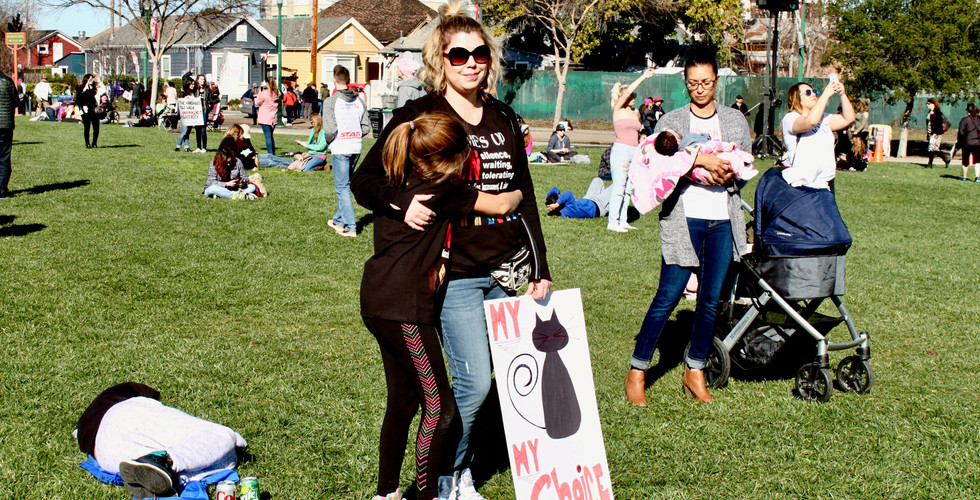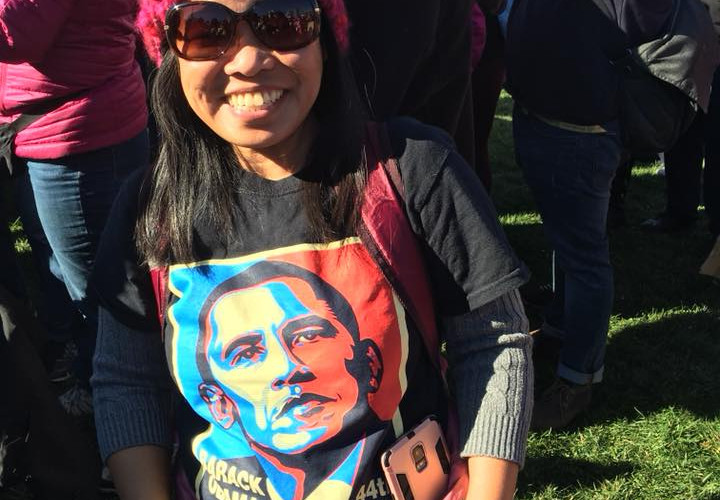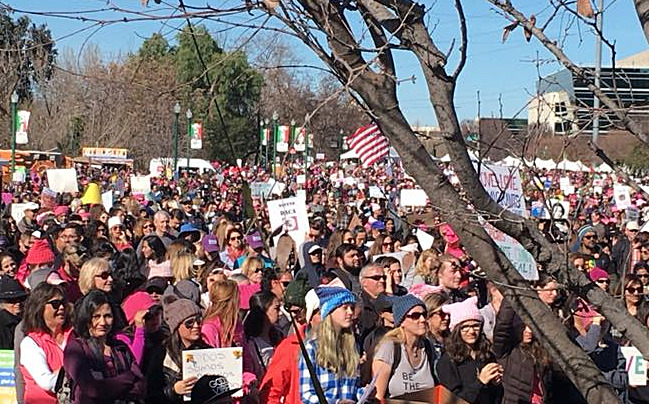Women's March Bay Area 2018: The Many Faces of Feminism
- Keana A. Labra
- Jan 21, 2018
- 6 min read

The Bay Area Women’s March is a popular movement that began last year. Spurring conversation across the country, social media has been slowly counting down the days until the march. Originating in Washington D.C., knowledge of the march has only reached a broader audience with locations following suit not only in the San Francisco Bay Area, but in the Midwest and the Eastern coast as well. There has been a surge of protest with the “Time’s Up” and “Me Too” hashtags, but the majority of women featured are white. Women of color, such as Vietnamese women, are not portrayed at the forefront of this movement as the voices of these women are drowned out by their white counterparts. Though feminism is not a common topic in the average Asian home, there are women already taking strides to make themselves visible within this movement.
Mercury News estimated in the previous Women’s March about 50,000 gathered in San Francisco and more than 25,000 showed in San Jose. According to CBS News, the numbers remained steady this year with an estimated 20,000 in San Jose. With these numbers, it seems unlikely that an Asian speaker would not be featured at the march, but that did not happen last year.

Luckily, this year on Saturday, January 20th, Ms. Vân Lan Trương, a community activist, represented the Vietnamese community. She gave a speech emphasizing the importance of voting. Not only are we grateful for her presence, but we are proud of the message she conveyed to her audience. Poised over the speakers heard throughout Arena Green Park, she confidently admitted, “Though I don’t speak perfect English, I understand THIS perfectly.”
Upon hearing her speech, a listener might question what is it that Ms. Trương “understands”?
Her speech highlighted the organizers’ goal to encourage participation in the 2018 midterm elections. Following the theme “Hear Our Votes,” she stated, “Now, it is more important than ever to cast our votes to make a difference. We have seen how even one vote can change the course of our freedom.” For many protesters, this march was in direct opposition of the Trump Administration. President Donald Trump has been accused of sexually assaulting nineteen women, per The Atlantic. Many individuals feel that Trump does not reflect the public’s view on respect and interaction with women and participating in the march voiced their disapproval. So who was in attendance? It certainly was not only women. Men and the LGBTQ community showed their solidarity with their presence and support. On the other hand, does it matter? Mirroring the previous year, there was a sea of pink shirts, “cat” hats, and feather boas. Was pink the official color?
No, it was not.
What is your definition on feminism? While the definition in your mind may be set (and include the color pink), it may not parallel that of another proclaimed feminist. Depending on a person’s upbringing and environment, there is a preconceived notion of what “feminism” is and what it means to be a feminist.
While there may be individuals apprehensive of the idea of feminism, it provides a sanctuary of acceptance for marginalized groups. One may argue Vietnamese women have been featured in Western pop culture since at least the late 1980’s, such as in the movie Full Metal Jacket, however, this portrayal is a standard stereotype of all Asian women: tall, thin, pale with long black hair and eager to please. Again, as feminism is not a normal concept introduced into an Asian home, it is important that this platform is provided to Asian youths as well.
Photo of a scene in Full Metal Jacket from Youtube.
Where does one even begin researching this broad a subject? Like other philosophies, navigating the nuances and particulars of feminism is overwhelming; an individual researching feminism for the first time may find themselves conflicted with finding ideologies that contradict themselves within the same movement. For example, there are stances of feminism staunchly rooted in radicalism; then, there is intersectional feminism which looks for solutions to bridge the gaps that race, ethnicity, social status, and sexual orientation may cause between all women.
In Roxane Gay’s, Bad Feminist, she addresses this issue by relating it to her own struggles with accepting feminism and labeling herself a feminist. She introduces the concept of the Feminist Pedestal: we revere women who do good by our own standards of what it means to be a feminist, but as soon as she deviates from what we consider “right,” we ostracize her.
Even within modern films, there are one-sided tropes of women: there is the Strong Female Lead, that of Sigourney Weaver as Ellen Ripley from Alien or Linda Hamilton as Sarah Conner from Terminator 2. These characterizations of a tough and gritty lead emerged with the good intention of emphasizing women as equal to men. However, a new question then arises: do women need to shed their femininity to be regarded as equal? These examples alone are enough to discourage some women from delving further into feminism.
While there are stereotypical depictions of white women (e.g. the ditzy blonde, airhead, girly-girl shopaholic, etc.), there are more frequent occurrences of stereotypes towards Asian women in film. In a video shared by the Coalition of Asian Pacifics in Entertainment, it shows specific instances of typecasting of Vietnamese women. As previously mentioned, movies all too regularly portray these women as the submissive, “delicate” accessory to the white man, who often hold leading roles in these films. The women cast for these roles are not even Vietnamese; for example, the prostitute in Full Metal Jacket is Chinese-British. Young Asian women watching these films might feel discouraged from ever seeing someone from their own ethnic background, perhaps even accepting that it may not ever occur in a major motion picture.
Gay describes women being skeptical to the word “feminist” due to the constraints it seems to place on how a woman should be. Her own experience with this is her confliction with liking the color pink and music with misogynistic lyrics (with the defense of having a catchy beat). Her unwillingness to fit into the mold of what is perceived as a “good feminist,” openly “embrace[s] the label of bad feminist” and asserts, “I do so because I am flawed and human.”
She states plainly “feminism is a choice, and if a woman does not want to be a feminist, that is her right, but it is my responsibility to fight for her rights ... I am in no position to tell women of other cultures what equality and freedom should look like.”
So who can be a feminist? We all can: woman, man, non-binary, and everyone in between. Men, as well, are taking the title upon themselves. In a short clip released by Refinery29, famous male celebrities declare succinctly why they are feminists. It is important for men to utilize their platform of privilege to supplement women’s voices as it isn’t enough just to state it; men need to also take action in their support of women’s rights.

With the 2018 Bay Area Women's March, men and women alike took this opportunity to show their stance for equality. Asian women should take the time as well to make their presence known, especially with the inclusion of Ms. Trương. After her speech, many women came up to congratulate her and shared their appreciation of the messages she shared; among them, a Vietnamese woman hugged her and clutched her hand as she confided how difficult it was for her to encourage her Vietnamese women friends to attend. Culture can change with knowledge, and it only takes one voice to encourage voices of many more. If Asian youths can be made aware of the benefits of feminism, then strides can be made within traditional family homes. Feminism can only thrive with inclusiveness.
Women are not just sisters, cousins, wives, or friends: we are all unique individuals with our own respective experiences. Feminism is the reminder that women are not passive sex objects or a glorified fetish. It not only advocates the equality between men and women but scrutinizes social gender roles and the negative effects it has on both sexes. Gay stresses a collective effort; only in working to understand each other can “feminism be pluralistic so long as we respect the different feminism we carry with us.” Being a woman is multi-faceted; that is the ultimate truth of feminism.

These are the official colors of Women’s March Bay Area: all of us in a united front with a better future in mind. Pink came about as a natural phenomenon, not pushed by the organizers. This is the celebration of all women and our stories. It is only together that we can make greater change.
If you like stories like this, subscribe to Chopsticks Alley.

Keana A. Labra - Milpitas, CA Contributor
Keana is a student at San Jose State University majoring in English Literature and Animation Illustration. She would like to one day integrate her two loves in the form of visual storytelling. She is an avid reader and enjoys studying poetry, mythologies, and philosophical treatises. In her free time, she can be found reading comics, taking pictures, or watching movies. As an Asian American, she would like to shed light on feminist works in the Asian community.

















































